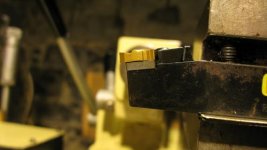B
Bentwood
Guest
On Center
I have worked for a large aircraft company and worked for an engineering group and did machining for them about 45 % of the work involved threading almost every type of material you can think of most of it was single point threading with HSS or carbide inserts or braised carbide We set every tool on center and never had any problems on every size lathe from 9" swing to 16" swing.Slow feed rates for HHS. and higher speeds and feeds for carbide.95% had Positive Back rakes and Positive Side clerance.
I have worked for a large aircraft company and worked for an engineering group and did machining for them about 45 % of the work involved threading almost every type of material you can think of most of it was single point threading with HSS or carbide inserts or braised carbide We set every tool on center and never had any problems on every size lathe from 9" swing to 16" swing.Slow feed rates for HHS. and higher speeds and feeds for carbide.95% had Positive Back rakes and Positive Side clerance.


